Peach palm
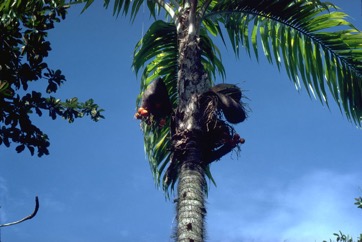
A tropical plant. It suits the hot, wet tropical lowlands. These palms have good wind resistance. They have a moderate tolerance of drought. They grow from sea level to 1200 m altitude in regions near the equator. It suits the wet tropics. It is grown from approximately 17°N to 16°S of the equator. It is most productive on deep well drained soils in the tropics below 800 m altitude and with a well distributed rainfall of 2000-5000 mm per year and a temperature above 24°C. It will grow on poor acid soils with low rainfall. It suits hardiness zones 11-12.
Also known as:
Cachipay, Chenga, Chichaguay, Chima, Chonta de Castilla, Chontaduro, Chunda yura, Dagenka, Gachipaes, Huanima, Jenga, Jijibre, Macanilla palma, Nalup, Oma, Palem pejibaye, Paripoe, Paripou, Pejibaye, Pejibayu, Pejivalle chontaduro, Pewa palm, Pijiguao, Pijuayo, Piraja-pupunha, Piriguao, Pisbae, Pupunha-maraja, Pupunha, Pupunheira, Siri, Supa, Tembe, Uwi, Uyai, Yaun, Ziri
Synonyms
- Bactris ciliata (R. & P.) C. Martius
- Bactris insignis (Mart.) Baillon
- Bactris speciosa (Mart.) H. Karst.
- Bactris speciosa var. chichagui (Mart.) H. Karst
- Bactris utilis (Oerst.) Benth. & Hook. ex Hemsl.
- Guilielma chontaduro Triana
- Guilielma ciliata (R & P) H.A.Wendland ex Kerchove
- Guilielma gasipaes (Kunth) L. H. Bailey
- Guilielma gasipaes var. chichagui (H. Karst.) Dahlgren
- Guilielma gasipaes var. chontaduro (Triana) Dugand
- Guilielma gasipaes var. flava (Barb.Rodr.) L.H.Bailey
- Guilielma gasipaes var. ochracea (Barb.Rodr.) L.H.Bailey
- Guilielma insignis Mart.
- Guilielma microcarpa Huber
- Guilielma speciosa Mart.
- Guilielma speciosa var. coccinea Barb.Rodr.
- Guilielma speciosa var. flava Barb.Rodr.
- Guilielma speciosa var. mitis Drude
- Guilielma speciosa var. ochracea Barb.Rodr.
- Guilielma utilis Oerst.
- Martinezia ciliata R.& P.
- Guilielma spinosa Mart.
Edible Portion
- Fruit, Flower shoots, Cabbage, Palm heart, Vegetable, Seed
Where does Peach palm grow?
Found in: Amazon, Andes, Argentina, Asia, Australia, Bolivia, Brazil, Central America, Colombia, Costa Rica, Ecuador, French Guiana, Guam, Guatemala, Guyana, Hawaii, Honduras, India, Indonesia, Nicaragua, Pacific, Panama, Papua New Guinea, PNG, Paraguay, Peru, Philippines, SE Asia, South America, Suriname, Trinidad and Tobago, United States, Venezuela
Notes: There are 239 Bactris species. There are 75 species in tropical America. Most Bactris have fruit that are edible but many are not attractive. The fruit are high in Vitamin A. The red variety has 2.76 mg of carotene while the yellow variety has 0.835 mg.
Status: It is a cultivated food plant. It has been introduced to Papua New Guinea. An important food in South America. In Papua New Guinea it occurs mostly only on research farms and knowledge of how to use the food is lacking.
Growing Peach palm
Cultivation: Plants can be grown from seeds or suckers. Normally only 4 suckers per plant are kept and others removed. Before taking the suckers it is best to partly cut them off and allow roots to develop more strongly. A spacing of 5-6 m apart is suitable. Mycorrhizae attached to the roots give fast growth rates. Under subsistence conditions palms are often widely spaced but for intensive agriculture it is planted at 400-500 plants/ha for fruit and 3000 to 20 000 plants for heart-of-palm. Plants are pollinated by insects but can be pollinated by wind. Small beetles are attracted to the flower and pollinate the plant in Central America. If using seeds, fresh seed should be planted. They germinate in 3-5 months.
Edible Uses: The fruit are used cooked or in preserves. The fruit is also dried and ground into flour. The flesh of the fruit is eaten raw. The fruit is boiled in salt water for 3 hours, the seeds removed then eaten. The kernel of the seeds is also edible. The palm cabbage is edible.
Production: Seeds normally germinate in 30-90 days under normal conditions. Palms grow rapidly under the best conditions. Palms commence bearing after 5-8 years and may produce for 70-80 years. Fruit is produced in large clusters of 50-100 fruit. Four or five clusters are produced per year. Fruiting is seasonal. Fruit takes 6 months to mature and keeps well on the tree. The number of mature fruits per inflorescence (commonly referred to as raceme or bunch) varies from 0 to 764, with total fruit weight 0-20 kg. The palms can be harvested for palm hearts 2.5-4 years after planting. Each palm yields 1.3 kg of edible heart.
Nutrition Info
per 100g edible portion| Edible Part | Energy (kcal) | Protein (g) | Iron (mg) | Vitamin A (ug) | Vitamin c (mg) | Zinc (mg) | % Water |
|---|---|---|---|---|---|---|---|
| Fruit | 196 | 0.5 | 1.5 | 280 | 35 | - | 50.5 |
| Flowers | - | - | - | - | - | - | |
| Palm heart | 47.6 | 1.5 | 0.23 | - | 3.2 | - | |
| Nuts | - | - | - | - | - | - |
Peach palm Photos

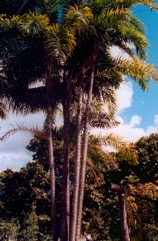
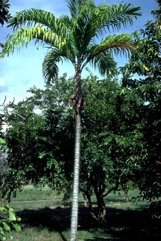
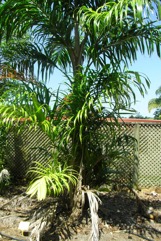
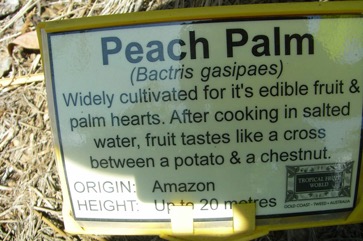
References
Ambasta S.P. (Ed.), 2000, The Useful Plants of India. CSIR India. p 65 (As Bactris utilis)
Asprilla-Perea, J., & Diaz-Puente, J.M., 2018, Traditional use of wild edible food in rural territories within tropical forest zones: A case study from the northwestern Colombia. New Trends and Issues Proceedings on Humanities and Social Sciences [Online]. 5(1), 162–181.
Balick, M.J. and Beck, H.T., (Ed.), 1990, Useful palms of the World. A Synoptic Bibliography. Colombia p 49, 57 (As Guilielma utilis), 61, 68, 70, 87, 153, 157 (As Guilielma insignis), 307, 311, 313, 317, 318, 419, 420, 421, 422, 473, 506, 561,
Barfod, A. S. & Kvist, L. P., 1996, Comparative Ethnobotanical Studies of the Amerindian Groups in Coastal Ecuador. The Danish Academy of Sciences and Letters. p 77, 80
Bennett, B. C., 1990, Useful Plants of Amazonian Ecuador. US Agency for International Development. Fifth Progress Report. New York Botanical Gardens. p 40
Bircher, A. G. & Bircher, W. H., 2000, Encyclopedia of Fruit Trees and Edible Flowering Plants in Egypt and the Subtropics. AUC Press. p 51 (Also as Bactris insignis, Bactris microcarpa, )
Blomberry, A. & Rodd, T., 1982, Palms. An informative practical guide. Angus & Robertson. p 61
Brickell, C. (Ed.), 1999, The Royal Horticultural Society A-Z Encyclopedia of Garden Plants. Convent Garden Books. p 158
Burkill, I.H., 1966, A Dictionary of the Economic Products of the Malay Peninsula. Ministry of Agriculture and Cooperatives, Kuala Lumpur, Malaysia. Vol 1 (A-H) p 284
Chizmar Fernandez, C., et al, 2009, Plantas comestibles de Centroamerica. Instituto de Biodiversidad, Costa Rica. p 75
Coe, F. G., and Anderson, G. J., 1996, Ethnobotany of the Garifuna of Eastern Nicaragua. Economic Botany 50(1) pp 71-107
Coe, F. G. and Anderson, G. J., 1999, Ethnobotany of the Sumu (Ulwa) of Southeastern Nicaragua and Comparisons with Miskitu Plant Lore. Economic Botany Vol. 53. No. 4. pp. 363-386
Coronel, R.E., 1982, Fruit Collections in the Philippines. IBPGR Newsletter p 6
Creed-kanashiro, H., et al, Traditional food system of an Awajun community in Peru. Indigenous Peoples' food systems Chp. 4
Darley, J.J., 1993, Know and Enjoy Tropical Fruit. P & S Publishers. p 82
Duchelle, A. E., 2007, Observations on Natural Resource use and Conservation by the Shuar In Ecuador's Cordillera del Condor. Ethnobotany Research & Applications 5:005-023
Etherington, K., & Imwold, D., (Eds), 2001, Botanica's Trees & Shrubs. The illustrated A-Z of over 8500 trees and shrubs. Random House, Australia. p 113
Eynden, Van den, V., & Cueva E., Cabrera, O., 2004, Edible Palms of Southern Ecuador. Palms. Vol 48(3):141-147
Facciola, S., 1998, Cornucopia 2: a Source Book of Edible Plants. Kampong Publications, p 29
Flowerdew, B., 2000, Complete Fruit Book. Kyle Cathie Ltd., London. p 162
French, B.R., 1986, Food Plants of Papua New Guinea, A Compendium. Asia Pacific Science Foundation p 301 (As Guilielma)
Gibbons, M., 1993, Palms. Compact study Guide and Identifier. Sandstone. p 20
Gibbons, M., 2003, A pocket guide to Palms. Chartwell Books. p 47
Grandtner, M. M., 2008, World Dictionary of Trees. Wood and Forest Science Department. Laval University, Quebec, Qc Canada. (Internet database http://www.WDT.QC.ca)
Grandtner, M. M. & Chevrette, J., 2013, Dictionary of Trees, Volume 2: South America: Nomenclature, Taxonomy and Ecology. Academic Press p 56 (Also as Bactris gasipaes var. chichagui) Haynes, J., & McLaughlin, J., 2000, Edible palms and Their Uses. University of Florida Fact sheet MCDE-00-50-1 p 3
Hedrick, U.P., 1919, (Ed.), Sturtevant's edible plants of the world. p 89
Henderson, A., Galeano, G and Bernal, R., 1995, Field Guide to the Palms of the Americas. Princeton. p 188
Hermandez Bermejo, J.E., and Leon, J. (Eds.), 1994, Neglected Crops. 1492 from a different perspective. FAO Plant Production and Protection Series No 26. FAO, Rome. p16, 211
Hermandez Bermejo, J.E., and Leon, J. (Eds.), 1994, Neglected Crops. 1492 from a different perspective. FAO Plant Production and Protection Series No 26. FAO, Rome. p 215 (As Bactris ciliata)
Hermandez Bermejo, J.E., and Leon, J. (Eds.), 1994, Neglected Crops. 1492 from a different perspective. FAO Plant Production and Protection Series No 26. FAO, Rome. p 215 (As Bactris insignis)
Hunter, D., et al, 2019, The potential of neglected and underutilized species for improving diets and nutrition. Planta (2019) 250:709-729
Janick, J. & Paul, R. E. (Eds.), 2008, The Encyclopedia of Fruit & Nuts. CABI p 93
Janos, D.P., 1977, Vesicular-arbuscular mycorrhizae affect the growth of Bactris gasipaes. Principes 21(1):12-18
Johannessen, C.L. 1966, Pejibayes in commercial cultivation. Turrialba 16(2): 181-187
Johnson, D.V., 1998, Tropical palms. Non-wood Forest products 10. FAO Rome. p 20, 125, 126
Jones, D.L., 1994, Palms throughout the World. Smithtonian Institution, Washington. p 55, 57, 139
Jones, D.L., 2000, Palms of Australia 3rd edition. Reed/New Holland. p 122
Kiple, K.F. & Ornelas, K.C., (eds), 2000, The Cambridge World History of Food. CUP p 1831
Leakey, R. R. B., 1999, Potential for novel food products from agroforestry trees: A review. Food Chemistry. 66:1-14
Lorenzi, H., 2002, Brazilian Trees. A Guide to the Identification and Cultivation of Brazilian Native Trees. Vol. 01 Nova Odessa, SP, Instituto Plantarum p 291
Macmillan, H.F. (Revised Barlow, H.S., et al) 1991, Tropical Planting and Gardening. Sixth edition. Malayan Nature Society. Kuala Lumpur. p 294
Marcia, M. J., et al, 2011, Palm Uses in Northwestern South America: A Quantitative Review. Bot. Rev. (2011) 77:462-570
Martin, F. W., et al, 1987, Perennial Edible Fruits of the Tropics. USDA Handbook 642 p 47
Menninger, E.A., 1977, Edible Nuts of the World. Horticultural Books. Florida p 128 (As Guilielma)
Mora-Urpí, Jorge, John C. Weber and Charles R. Clement. 1997. Peach palm. Bactris gasipaes Kunth. Promoting the conservation and use of underutilized and neglected crops. 20. Institute of Plant Genetics and Crop Plant Research, Gatersleben/ International Plant Genetic Resources Institute, Rome, Italy.
Morton, J. F., 1987, Fruits of Warm Climates. Wipf & Stock Publishers p 12
Paz, F. S., et al, 2021, Edible Fruit Plant Species in the Amazon Forest Rely Mostly on Bees and Beetles as Pollinators. Journal of Economic Entomology, XX(XX), 2021, 1–13
PROSEA (Plant Resources of South East Asia) handbook, Volume 2, 1991, Edible fruits and nut. p 98
Purseglove, J.W., 1972, Tropical Crops. Monocotyledons. Longmans p 424 (As Guilielma)
Riffle, R.L. & Craft, P., 2003, An Encyclopedia of Cultivated Palms. Timber Press. p 267
Rosero-Toro, et al, 2018, Cultural significance of the flora of a tropical dry forest in the Doche vereda (Villavieja, Huila, Colombia). Journal of Ethnobiology and Ethnomedicine (2018) 14:22 p 11
Schneider, E., 2001, Vegetables from Amaranth to Zucchini: The essential reference. HarperCollins. p 462
Smith, N., et al, 2007, Amazon River Fruits. Flavors for Conservation. Missouri Botanical Gardens Press. p 58
Stone, B. C., 1970, The Flora of Guam. A Manual for the Identification of the Vascular Plants of the Island. Micronesica. Journal of the University of Guam. p 139
Sukarya, D. G., (Ed.) 2013, 3,500 Plant Species of the Botanic Gardens of Indonesia. LIPI p 758
Tankard, G., 1990, Tropical fruit. An Australian Guide to Growing and using exotic fruit. Viking p 113
USDA, ARS, National Genetic Resources Program. Germplasm Resources Information Network - (GRIN). [Online Database] National Germplasm Resources Laboratory, Beltsville, Maryland. Available: www.ars-grin.gov/cgi-bin/npgs/html/econ.pl (10 April 2000)
Vael, L., 2015, Ethnobotanical study of the plant use in the natural landscape of two mestizo communities in the Ucayali region of the Peruvian Amazon. Universiteit Gent.
Van den Eynden, V., et al, 2003, Wild Foods from South Ecuador. Economic Botany 57(4): 576-603
van Wyk, B., 2005, Food Plants of the World. An illustrated guide. Timber press. p 83
Vasquez, R. and Gentry, A. H., 1989, Use and Misuse of Forest-harvested Fruits in the Iquitos Area. Conservation Biology 3(4): 350f
Vasquez, Roberto Ch. & Coimbra, German S., 1996, Frutas Silvestres Comestibles de Santa Cruz. p 160
Villachica, H., (Ed.), 1996, Frutales Y hortalizas promisorios de la Amazonia. FAO, Lima. p 217
F. W. H. A. von Humboldt et al., Nov. gen. sp. 1:242[folio]; 1:302[quarto]. 1816, nom. cons.
Wickens, G.E., 1995, Edible Nuts. FAO Non-wood forest products. FAO, Rome. p 88, 163
Wong, M., 2006, Edible Plants for Hawai'i Landscapes. College of Tropical Agriculture and Human Resources. Univ. of Hawai'i
World Checklist of Useful Plant Species 2020. Royal Botanic Gardens, Kew
www.colecionandofrutas.org
Zaldivar, M. E., et al, 2002, Species Diversity of Edible Plants Grown in Homegardens of Chibehan Amerindians from Costa Rica. Human Ecology, Vol. 30, No. 3, pp. 301-316
Zambrana, P, et al, 2017, Traditional knowledge hiding in plain sight – twenty-first century ethnobotany of the Chácobo in Beni, Bolivia. Journal of Ethnobiology and Ethnomedicine (2017) 13:57
Zuchowski W., 2007, Tropical Plants of Costa Rica. A Zona Tropical Publication, Comstock Publishing. p 382